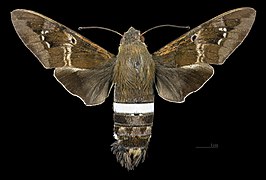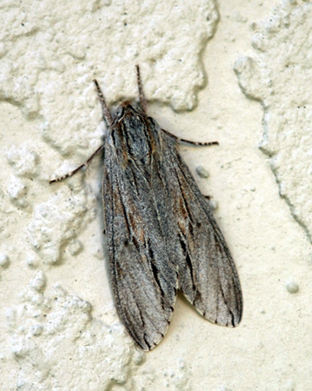
Isoparce cupressi, the baldcypress sphinx or cypress sphinx, is a moth of the family Sphingidae.

Manduca muscosa, the muscosa sphinx, is a moth of the family Sphingidae.

Manduca occulta, the occult sphinx, is a moth of the family Sphingidae.

Sphinx asellus, the asellus sphinx moth, is a moth of the family Sphingidae. The species was first described by Walter Rothschild and Karl Jordan in 1903. It is known from pinyon-juniper woodland and similar arid areas in the US states of Colorado, Nevada, Utah, extreme south-western Wyoming, Arizona, New Mexico and south-western Texas.
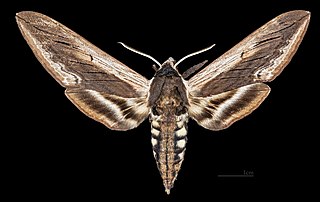
Sphinx drupiferarum, the wild cherry sphinx, is a moth of the family Sphingidae. The species was first described by James Edward Smith in 1797.

Lapara bombycoides, the northern pine sphinx is a moth of the family Sphingidae. The species was first described by Francis Walker in 1856.

Pachylia ficus, known as the fig sphinx, is a moth of the family Sphingidae. It lives from the northern tip of South America in Uruguay through Central America to the southern tip of the United States straying into Arizona and Texas.

Perigonia lusca, the half-blind sphinx or coffee sphinx, is a moth of the family Sphingidae. It was first described by Johan Christian Fabricius in 1777.

Aellopos ceculus is a moth of the family Sphingidae.
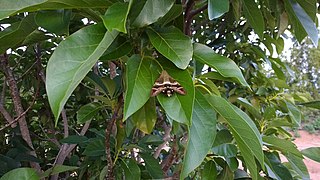
Aellopos fadus, the Fadus sphinx, is a moth of the family Sphingidae. The species was first described by Pieter Cramer in 1776.
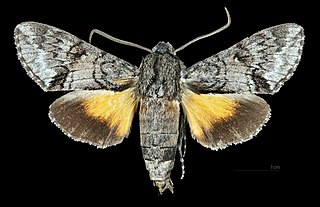
Cautethia grotei, or Grote's sphinx, is a moth of the family Sphingidae. It was described by Henry Edwards in 1882.

Enyo lugubris, the mournful sphinx, is a moth of the family Sphingidae. It is found from Argentina and Paraguay to Uruguay, Venezuela, Guyana, Suriname, French Guiana, Colombia, Ecuador, Peru, Brazil and the West Indies through Belize, Guatemala, Honduras, El Salvador, Nicaragua, Costa Rica and Panama to Mexico and the United States, where it has been recorded from Arizona east to Florida and north to South Carolina. Strays have been recorded from Arkansas, north to Illinois, Michigan and New York.

Eumorpha vitis, known as the vine sphinx, is a moth of the family Sphingidae.
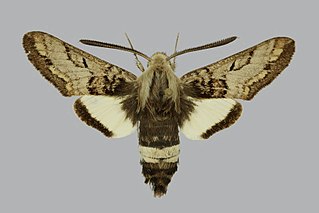
The prairie sphinx moth or Wiest's primrose sphinx is a species of moth in the family Sphingidae. It is found in the Western United States. The habitat consists of sand washes and prairie blow-outs.

The genus Aellopos consists of large day-flying moths in the family Sphingidae. It was first described by Jacob Hübner in 1819. Species in this genus occur from Maine in the United States through Central America and down to Argentina and Uruguay in South America.

Aellopos tantalus, known as the Tantalus sphinx, is a moth of the family Sphingidae. It is found in Florida, the Antilles, from Mexico to Venezuela, Colombia, Ecuador, Suriname, and in the Amazon basin.

Aellopos blaini is a moth of the family Sphingidae. It is found in Cuba, Jamaica, Hispaniola and Puerto Rico.

Callionima parce, the parce sphinx moth, is a species of moth in the family Sphingidae.It was originally described by Johan Christian Fabricius in 1775.

Erinnyis pallida, the pallid sphinx, is a moth of the family Sphingidae. The species was first described by Augustus Radcliffe Grote in 1865. It is known to be common in Cuba.

Eupyrrhoglossum sagra, the Cuban sphinx, is a moth of the family Sphingidae. The species was first described by Felipe Poey in 1832. It is known from tropical and subtropical lowlands in Cuba and from Mexico and Belize to Guatemala, Costa Rica, Bolivia, Paraguay, Argentina and Uruguay. Occasionally, strays are found in Florida.


